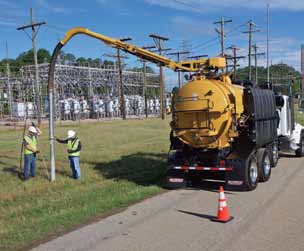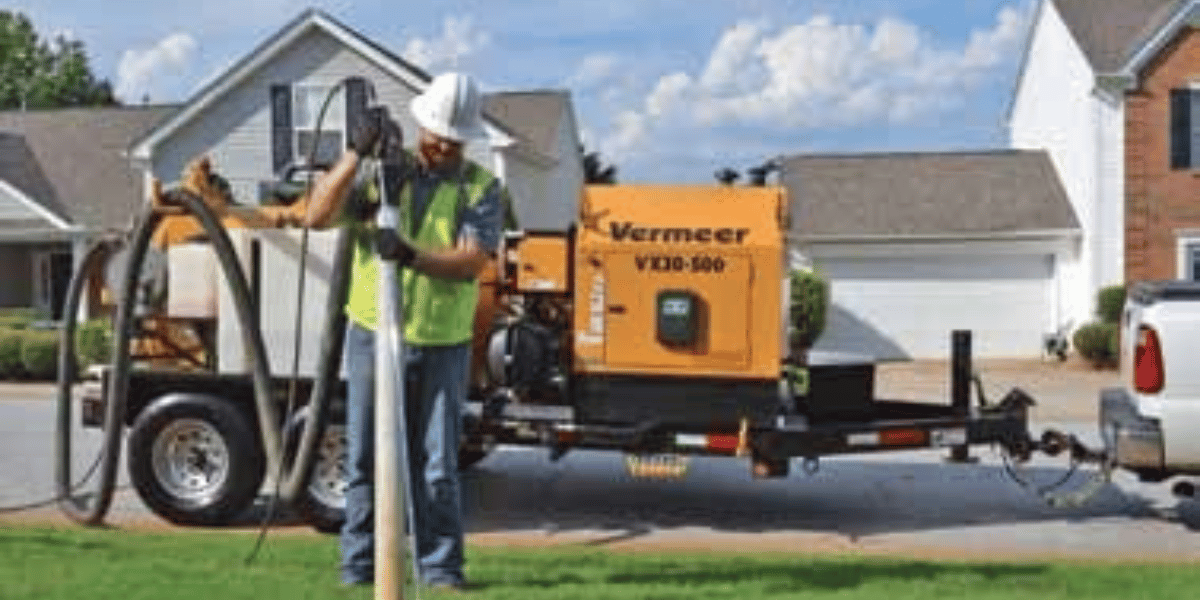With congested underground easements and roadways, it is becoming increasingly important to visually identify the location of underground utilities such as gas, fiber, water, telecommunications and sewer to prevent an accidental utility strike. However, using a compact excavator or a shovel to expose the line could also damage a utility. To reduce the risk of damaging existing utilities, underground contractors and municipalities have started using vacuum excavators, commonly called soft excavation. Over the last two decades, there has been a rise in demand for these machines.
According to Jake Jeffords, director of sales and marketing for McLaughlin Underground, the increasing number of buried utilities that occupy the rights-of-way of city streets is the driving force behind the expanded use of vacuum excavators. “Before digging for a new utility line, a call must be placed to 811/One Call so existing utilities can be marked,” he explained. “However, on almost every utility job, the contractor must expose any buried lines that a new installation may cross to help avoid unknowingly striking an existing utility, and using a vacuum excavator is an efficient and nondestructive way to do that.”
The use of vacuum excavators extends beyond exposing underground utilities. They are used by HDD crews to suck up the mixing fluids used while boring. Municipalities and sign installers also use vacuum excavators for digging because the process helps minimize restoration work after a hole is dug.
“To get the most from these machines, contractors and municipalities should take the time to understand how vacuum excavators work and the different options available on the market today,” Jeffords suggested.
HOW IT WORKS
Vacuum excavators use high-pressure water or compressed air to penetrate and break up soil and the unit’s powerful vacuum to remove the loose material. Often called potholing or keyholing, this soft excavation method can quickly expose buried utilities without causing damage to buried conduit, pipe or lines in the process.
“A lot of science is involved with the process,” Jeffords explained. “Inches of mercury, CFM, cyclonic filtration — these are all associated terms that help explain how a unit will perform in the field. To make sense of all the specifications, it’s important for a user to have a basic understanding of technical components, including blower type, volume of air and pressure being created.”
VACUUM BLOWER
There are two primary types of blowers in vacuum excavators: positive displacement and centrifugal units. With positive displacement blowers, air enters a blower and is trapped against a cylinder until it is forced, or displaced, through a discharge pipe. This type of blower is becoming the most common for potholing due to its ability to maintain velocity and airflow when in operation. A centrifugal blower typically uses rotating impellers or blades to increase the pressure or the air before discharging it.
VOLUME OF AIR
The term “CFM” stands for cubic feet per minute and is a measure of the volume of air being moved.

For optimal performance, the CFM specification on a vacuum excavator must be in direct correlation to the diameter of the hose on the machine used. Optimal hose size will depend on the type of spoil most commonly being removed. Cobble, for example, will be easier to remove with a four-inch (10 cm) or larger hose and will require a larger blower. Less challenging ground conditions might only require a three-inch (7.6 cm) hose and less CFM. The key is having enough velocity so the spoils that enter the hose are suspended until they reach the tank. If the material settles in the hose, it could clog the system.
PRESSURE
Inches of mercury (psi) is a unit of measurement for pressure. It is a function of how much material the vacuum excavator can move, or lift, at a time. For example, 15 inches (38 cm) of mercury is the lift involved to be able to pull a column of water 17 feet (5 m) into the air. The industry standard for trailer-mounted units (and for potholing and most drill fluid cleanup applications) is 15 inches (38 cm) of mercury. More inches of mercury may be beneficial when dealing with heavy fluid or slurry.
CHOOSING THE RIGHT UNIT
There are a lot of different manufacturers and models of vacuum excavators in the market and buyers should weight their options carefully. It is important to ensure they get the right unit for their needs, as well as the necessary service and support they will require in the future.
Many manufacturers offer truck- and trailer-mounted vacuum excavators with a range of tank sizes starting with 300 gallons (1135 L). Models also vary in the amount of material they can displace, the volume of air being moved and suction pressure.
Evaluating the dealer and their service and support when shopping for a vacuum excavator is also important. While vacuum excavators are not challenging to operate or much different from other machines to service, having a local dealer that is familiar with them will shorten the amount of time spent learning. Since vacuum excavators usually are not a mainline product for most equipment dealers, finding local support can be a challenge. Buyers should seek out reputable underground construction dealers with multiple locations, so help is never far away.
ADDING VERSATILITY
Vacuum excavators can be equipped with additional options and accessories to increase their versality. The most popular ones include hydraulic booms to make handling the hose easier, a hot box that warms the water coming out of the high-pressure wand, a core saw for potholing through pavement and concrete, as well as a sewer jester for cleaning pipes.
There is also a list of accessories that will increase the number of applications vacuum excavators can be used for including sweepers and cleaners, which can help clean up a jobsite after an outdoor event, as well as a misting ring to help handle dry dust and debris during microtrenching applications.
The use of vacuum excavators is on the rise not only out of necessity, but also viability. The ability to quickly and effectively remove dirt and debris is important to contractors and municipalities. However, before setting out into the streets, buyers should compare manufacturers and models to ensure they are getting exactly what they need.
Reed Munro is Marketing Coordinator for McLaughlin Underground. For more information on vacuum excavators visit McLaughlinUnderground.com.

Comments